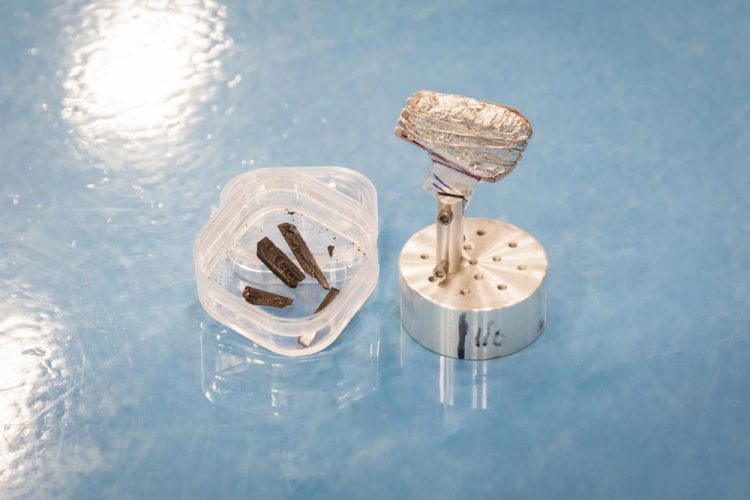Neutrons detect elusive Higgs amplitude mode in quantum material

The ORNL-led research team selected a crystal composed of copper bromide -- because the copper ion is ideal for studying exotic quantum effects -- to observe the elusive Higgs amplitude mode in two dimensions. The sample was examined using cold neutron triple-axis spectrometer beams for neutron scattering at the High Flux Isotope Reactor. Credit: Genevieve Martin, Oak Ridge National Laboratory/Dept. of Energy
The Higgs amplitude mode is a condensed matter cousin of the Higgs boson, the storied quantum particle theorized in the 1960s and proven experimentally in 2012. It is one of a number of quirky, collective modes of matter found in materials at the quantum level. By studying these modes, condensed matter researchers have recently uncovered new quantum states known as quasiparticles, including the Higgs mode.
These studies provide unique opportunities to explore quantum physics and apply its exotic effects in advanced technologies such as spin-based electronics, or spintronics, and quantum computing.
“To excite a material's quantum quasiparticles in a way that allows us to observe the Higgs amplitude mode is quite challenging,” said Tao Hong, an instrument scientist with ORNL's Quantum Condensed Matter Division.
Although the Higgs amplitude mode has been observed in various systems, “the Higgs mode would often become unstable and decay, shortening the opportunity to characterize it before losing sight of it,” Hong said.
The ORNL-led team offered an alternative method. The researchers selected a crystal composed of copper bromide, because the copper ion is ideal for studying exotic quantum effects, Hong explained. They began the delicate task of “freezing” the material's agitating quantum-level particles by lowering its temperature to 1.4 Kelvin, which is about minus 457.15 degrees Fahrenheit.
The researchers fine-tuned the experiment until the particles reached the phase located near the desired quantum critical point–the sweet spot where collective quantum effects spread across wide distances in the material, which creates the best conditions to observe a Higgs amplitude mode without decay.
With neutron scattering performed at ORNL's High Flux Isotope Reactor, the research team observed the Higgs mode with an infinite lifetime: no decay.
“There's an ongoing debate in physics about the stability of these very delicate Higgs modes,” said Alan Tennant, chief scientist of ORNL's Neutron Sciences Directorate. “This experiment is really hard to do, especially in a two-dimensional system. And, yet, here's a clear observation, and it's stabilized.”
The research team's observation provides new insights into the fundamental theories underlying exotic materials including superconductors, charge-density wave systems, ultracold bosonic systems and antiferromagnets.
“These breakthroughs are having widespread impact on our understanding of materials' behavior at the atomic scale,” Hong added.
###
The study, titled, “Direct observation of the Higgs amplitude mode in a two-dimensional quantum antiferromagnet near the quantum critical point,” was published in Nature Physics. It was co-authored by ORNL's Tao Hong, Sachith E. Dissanayake, Harish Agrawal and David A. (Alan) Tennant, and scientists from Shizuoka University, the National Institute of Standards and Technology, University of Maryland, University of Jordan, Clark University, Helmholtz-Zentrum Berlin for Materials and Energy and Lehrstuhl für Theoretische Physik I.
The team used cold neutron triple-axis spectrometer beams for studying exotic magnetic effects and analyzed low-energy excitations in the copper bromide compound. The unpolarized neutron scattering measurements were performed at ORNL's HFIR and at Helmholtz-Zentrum Berlin for Materials and Energy. For contrasting data from polarized neutron-scattering measurements, they also employed a high-intensity multi-axis crystal spectrometer at NIST's Center for Neutron Research.
The work performed at ORNL's HFIR, a DOE Office of Science User Facility, and was funded by the DOE Office of Science.
UT-Battelle manages ORNL for DOE's Office of Science. The Office of Science is the single largest supporter of basic research in the physical sciences in the United States, and is working to address some of the most pressing challenges of our time. For more information, please visit http://science.
Media Contact
All latest news from the category: Physics and Astronomy
This area deals with the fundamental laws and building blocks of nature and how they interact, the properties and the behavior of matter, and research into space and time and their structures.
innovations-report provides in-depth reports and articles on subjects such as astrophysics, laser technologies, nuclear, quantum, particle and solid-state physics, nanotechnologies, planetary research and findings (Mars, Venus) and developments related to the Hubble Telescope.
Newest articles

A ‘language’ for ML models to predict nanopore properties
A large number of 2D materials like graphene can have nanopores – small holes formed by missing atoms through which foreign substances can pass. The properties of these nanopores dictate many…

Clinically validated, wearable ultrasound patch
… for continuous blood pressure monitoring. A team of researchers at the University of California San Diego has developed a new and improved wearable ultrasound patch for continuous and noninvasive…

A new puzzle piece for string theory research
Dr. Ksenia Fedosova from the Cluster of Excellence Mathematics Münster, along with an international research team, has proven a conjecture in string theory that physicists had proposed regarding certain equations….



